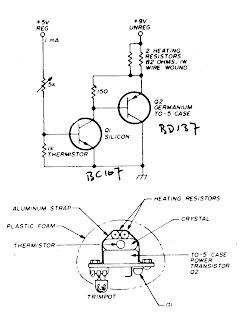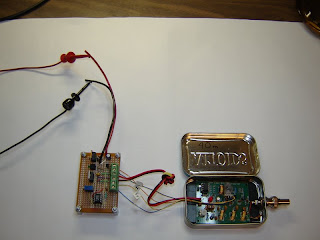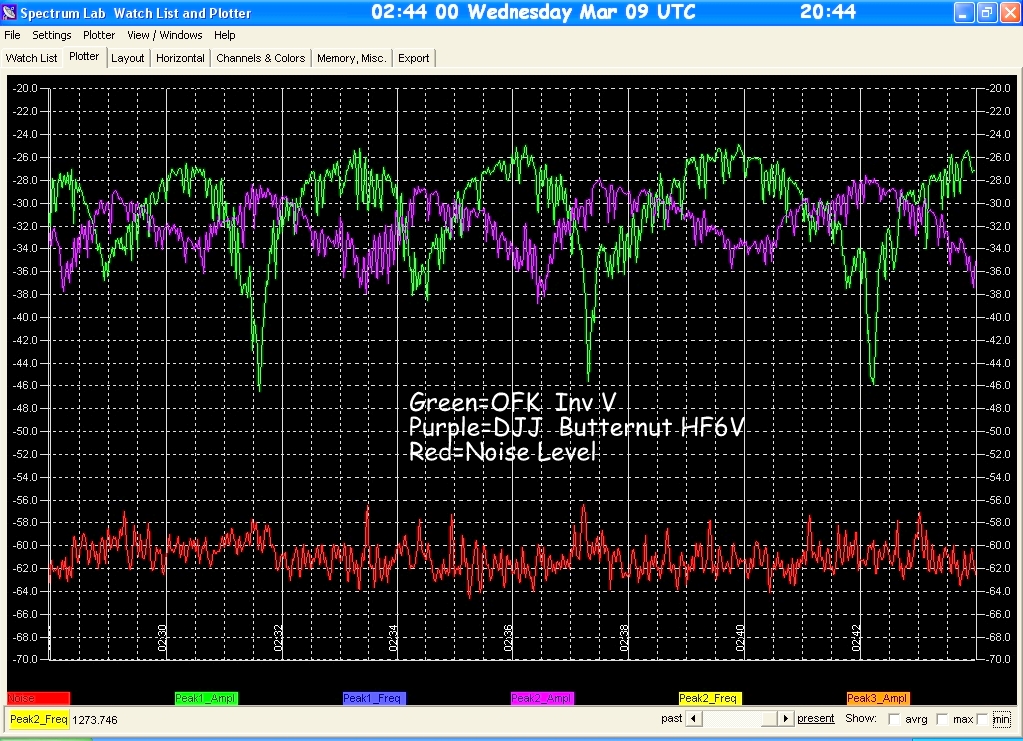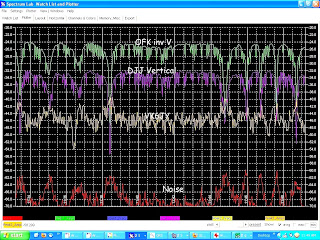The crystal oscillators used in our MEPTs tend to drift with temperature by about a Hz for each degree of temperature. Generally this is not a problem and does not limit the fun to be had with QRSS but for more advanced work control of frequency to within a Hz is desirable.
To get some idea of what the problem is like, I made measurements of the effect of temperature on both my MEPT and my rx, a TS-440. The first figure is a plot of data I acquired for the 10140 kHz crystal in my homebrew MEPT. Notice several things. First, the linear region on the left is typical of room temperature from which we can deduce a rate of 1.4 Hz/degF or 2.4 Hz/degC. Second, there is an inflection point labeled "Turnaround Point" where the frequency changes very little with temperature...this is the optimum operating temperature of a crystal. The curve for the rx is oposite that of the tx because the rx involves a hetrodyning process. I think these numbers are typical of all our QRSS crystals since they are of the AT cut because they are the cheapest and most affordable.

Figure 1. Frequency change with temperature for 10140 kHz crystal
Figure 2. Frequency Change with Temperature for my TS-440
Now, let's look at some methods of controlling temperature. When I built my first MEPT I copied most of my circuitry from
WA5DJJ who has done an excellent job of documenting his work. I also used his temperature control circuitry but modified it a bit to fit the components in my junk box. The most significant change was the use of an LM-34 temperature sensor which reads out directly in degrees F at the rate of 10mV per degree. Use the LM-35 for Celsius. The schematic of my controller is shown in Figure 3.
Figure 3. Temperature Controller Circuit Used at W4HBK
The LM-34 and 30 Ohm heating resistors are mounted on the crystal with good thermal contact and the other components at a convenient location elsewhere. The way it works is that the OpAmp compares a known voltage from the Zener-potentiometer combination (Set Point) with that measured by the LM-34 and switches on the heater resistors until a balance is obtained thus holding the temperature at the SP. Other OpAmps can be used but you may need a feedback resistor from the output back to the non-inverting input (+). I've use both the LM-358 and TL082 but found the LM-741 difficult to work with.
The next step was to make a sleeve out of copper foil that would fit snugly around the crystal, as shown in Figure 4. When soldering the sleeve closed be careful not to let solder flow under the seam an to the crystal. This will help distribute the heat and allow retrofit to an existing crystal, which is what I did later when adding temperature control to my TS-440. Four wires are required to connect to the control circuitry and should be as small as feasible so as not to conduct heat away from the crystal. Figure 5 shows how I glued the LM-34 and heater resistors to the copper sleeve using cyanoacrylate "SuperGlue".
.Figure 4. Copper Sleeve for Crystal
Figure 5. LM-34 and Heater Resistors Glued to Copper Sleeve
Figure 6 shows how it all comes together with the main components of the temperature controller located a short distance from the copper sleeve containing the LM-34 sensor and 30 Ohm heater resistors. As a final touch I whittled out a small cube of Styrofoam to fit snugly around the crystal assembly to minimize heating requirements and provide some isolation from the other heat-generating parts of the rig.
Figure 6. My 30m MEPT showing how the crystal heater is connected to the control circuitry.
Mike, N0QBH emailed me asking for info about my temperature controller and I sent him much of the above data. Figure 7 shows the really neat way he incorporated it in his QRP Labs MEPT . Figure 8 is a close up of the crystal assembly. Placing the components on the short crystals is more difficult that on the larger ones. Note that there is a copper jacket around the little crystal. There are more details at
Mikes WebPage.
Figure 6. N0QBH's version of my temperature controller
Figure 7. Close up view of components mounted on crystal
I have recently tried a new temperature control circuit which has only 4 parts, ALL mounted on the crystal. I use in on my 80m QRP Labs rig and so far it works about as well as the one I just described. But I'm tired of typing tonight and will add a description of it to this post at a later time. I will also tell you how I added a temperature controller to my TS-440.
de w4hbk















